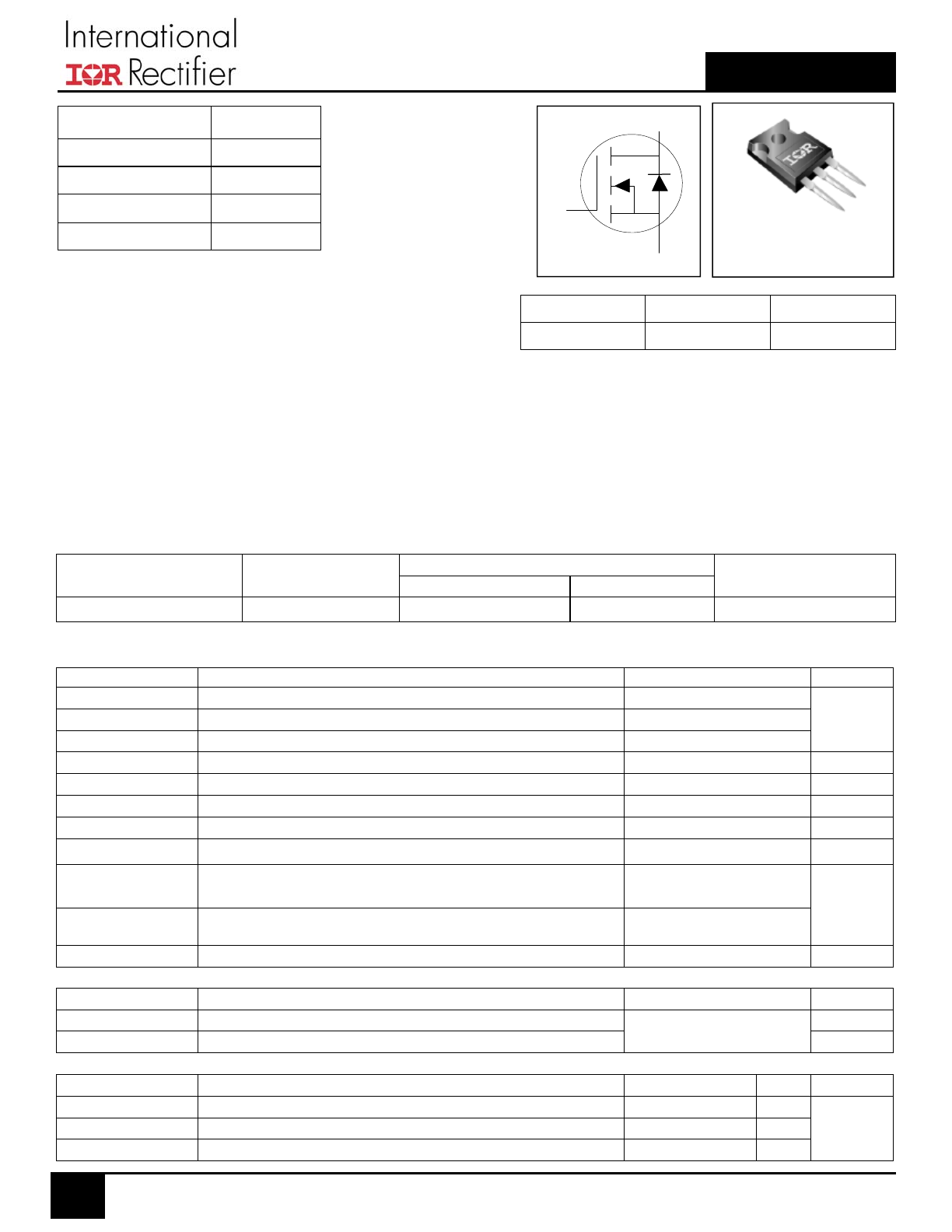
IRFP3006PbF
1
www.irf.com
© 2013 International Rectifier
September 06, 2013
Applications
High Efficiency Synchronous Rectification in SMPS
Uninterruptible Power Supply
High Speed Power Switching
Hard Switched and High Frequency Circuits
Benefits
Improved Gate, Avalanche and Dynamic dV/dt
Ruggedness
Fully Characterized Capacitance and Avalanche SOA
Enhanced body diode dV/dt and dI/dt Capability
Lead-Free
Gate Drain Source
G D S
V
DSS
60V
R
DS(on)
typ.
2.1m
max.
2.5m
I
D (Silicon Limited)
270A
I
D (Package Limited)
195A
Base Part Number
Package Type
Standard Pack
Orderable Part Number
Form Quantity
IRFP3006PbF
TO-247
Tube
25 IRFP3006PbF
Absolute Maximum Ratings
Symbol Parameter
Max.
Units
I
D
@ T
C
= 25°C
Continuous Drain Current, V
GS
@ 10V (Silicon Limited)
270
A
I
D
@ T
C
= 100°C
Continuous Drain Current, V
GS
@ 10V(Silicon Limited)
190
I
DM
Pulsed Drain Current 1080
P
D
@T
C
= 25°C
Maximum Power Dissipation
375
W
Linear Derating Factor
2.5
W/°C
V
GS
Gate-to-Source Voltage
± 20
V
T
J
Operating Junction and
-55 to + 175
°C
T
STG
Storage Temperature Range
Soldering Temperature, for 10 seconds
(1.6mm from case)
300
Mounting torque, 6-32 or M3 screw
10lbf
in (1.1N
m)
Avalanche Characteristics
E
AS (Thermally limited)
Single Pulse Avalanche Energy 320
mJ
I
AR
Avalanche Current
See Fig. 14, 15, 22a, 22b
A
E
AR
Repetitive Avalanche Energy
mJ
Thermal Resistance
Symbol Parameter Typ.
Max.
Units
R
JC
Junction-to-Case
–––
0.4
R
CS
Case-to-Sink, Flat Greased Surface
0.24 –––
°C/W
R
JA
Junction-to-Ambient
––– 40
I
D
@ T
C
= 25°C
Continuous Drain Current, V
GS
@ 10V (Wire Bond Limited)
195
dv/dt
Peak Diode Recovery 10
V/ns
TO-247AC
G
D
S
D
S
G
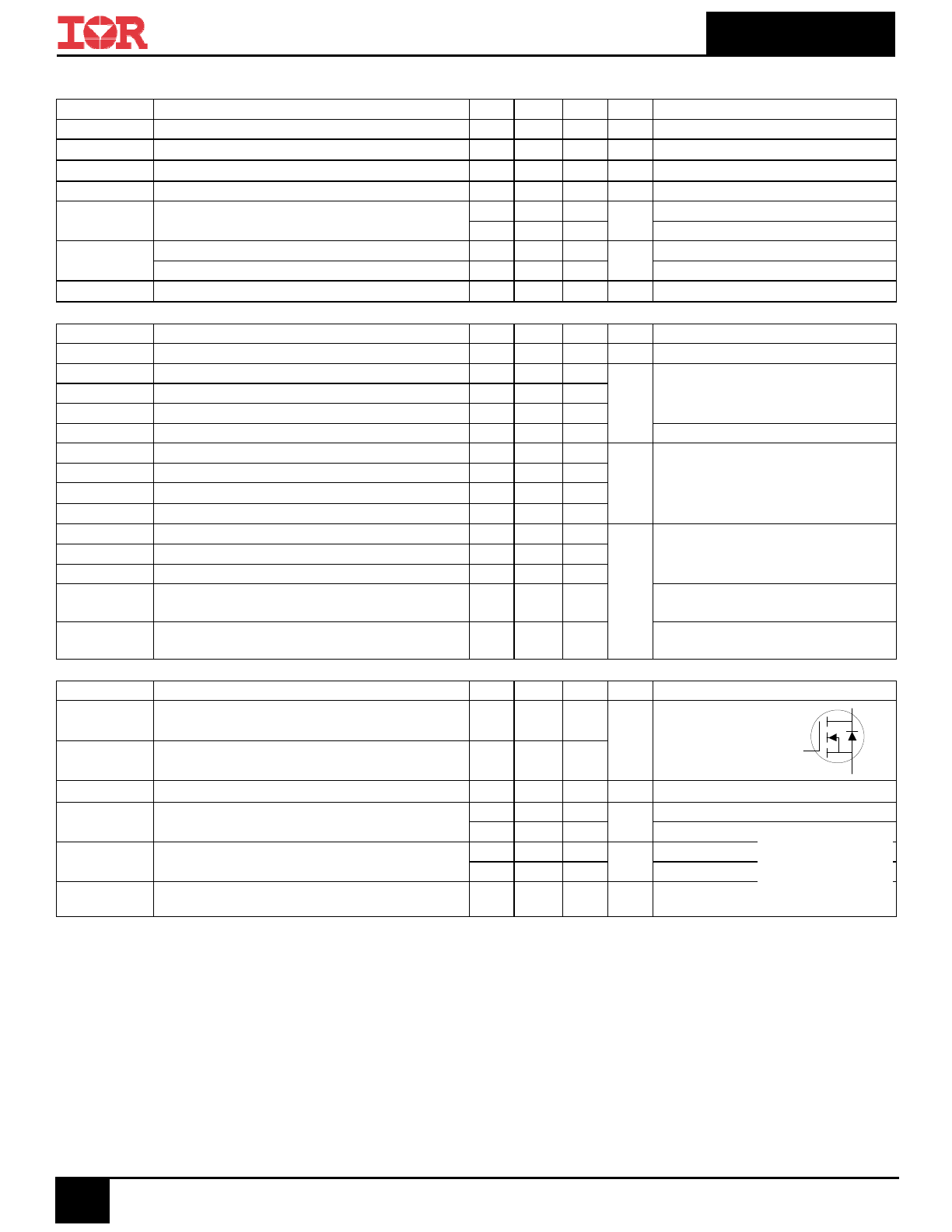
IRFP3006PbF
2
www.irf.com
© 2013 International Rectifier
September 06, 2013
Static @ T
J
= 25°C (unless otherwise specified)
Symbol Parameter
Min.
Typ.
Max.
Units
Conditions
V
(BR)DSS
Drain-to-Source Breakdown Voltage
60
––– –––
V V
GS
= 0V, I
D
= 250µA
V
(BR)DSS
/
T
J
Breakdown Voltage Temp. Coefficient
––– 0.07 ––– V/°C Reference to 25°C, I
D
= 5mA
R
DS(on)
Static Drain-to-Source On-Resistance
–––
2.1
2.5
m
V
GS
= 10V, I
D
= 170A
V
GS(th)
Gate Threshold Voltage
2.0
–––
4.0
V V
DS
= V
GS
, I
D
= 250µA
I
DSS
Drain-to-Source Leakage Current
––– –––
20
µA V
DS
= 60V, V
GS
= 0V
––– ––– 250
V
DS
= 60V, V
GS
= 0V, T
J
= 125°C
I
GSS
Gate-to-Source Forward Leakage –––
–––
100
nA
V
GS
= 20V
Gate-to-Source Reverse Leakage
––– ––– -100
V
GS
= -20V
R
G
Internal Gate Resistance
–––
2.0
–––
Dynamic @ T
J
= 25°C (unless otherwise specified)
Symbol Parameter
Min.
Typ.
Max.
Units
Conditions
gfs Forward
Transconductance
280
–––
–––
S
V
DS
= 25V, I
D
= 170A
Q
g
Total Gate Charge
––– 200 300
nC
I
D
= 170A
Q
gs
Gate-to-Source Charge
–––
37
–––
V
DS
=30V
Q
gd
Gate-to-Drain ("Miller") Charge
––– 60 –––
V
GS
= 10V
Q
sync
Total Gate Charge Sync. (Q
g
- Q
gd
) –––
140
–––
I
D
= 170A, V
DS
=0V, V
GS
= 10V
t
d(on)
Turn-On Delay Time
–––
16
–––
ns
V
DD
= 39V
t
r
Rise Time
––– 182 –––
I
D
= 170A
t
d(off)
Turn-Off Delay Time
––– 118 –––
R
G
= 2.7
t
f
Fall Time
––– 189 –––
V
GS
= 10V
C
iss
Input Capacitance
––– 8970 –––
pF
V
GS
= 0V
C
oss
Output Capacitance
––– 1020 –––
V
DS
= 50V
C
rss
Reverse Transfer Capacitance
––– 534 –––
ƒ = 1.0 MHz, See Fig. 5
C
oss
eff. (ER) Effective Output Capacitance
(Energy Related)
––– 1480 –––
V
GS
= 0V, V
DS
= 0V to 48V
See Fig. 11
C
oss
eff. (TR) Effective Output Capacitance
(Time Related)
––– 1920 –––
V
GS
= 0V, V
DS
= 0V to 48V
Diode Characteristics
Symbol
Parameter
Min. Typ. Max. Units
Conditions
I
S
Continuous Source Current
––– ––– 257
A
MOSFET symbol
(Body Diode)
showing the
I
SM
Pulsed Source Current
––– ––– 1028
integral reverse
(Body Diode)
p-n junction diode.
V
SD
Diode Forward Voltage
––– –––
1.3
V T
J
= 25°C, I
S
= 170A, V
GS
= 0V
t
rr
Reverse Recovery Time
–––
44
–––
ns T
J
= 25°C
––– 48 –––
T
J
= 125°C
Q
rr
Reverse Recovery Charge
–––
63
–––
nC T
J
= 25°C
––– 77 –––
T
J
= 125°C
I
RRM
Reverse Recovery Current
–––
2.4
–––
A T
J
= 25°C
Notes:
Calculated continuous current based on maximum allowable junction temperature. Bond wire current limit is 195A.Note that
current limitations arising from heating of the device leads may occur with some lead mounting arrangements. (Refer to AN-1140)
Repetitive rating; pulse width limited by max. Junction temperature.
Limited by T
Jmax
, starting T
J
= 25°C, L = 0.022mH, R
G
= 50
, I
AS
= 170A,V
GS
=10V. Part not Recommended for use above
this value.
ISD ≤ 170A, di/dt ≤ 1360A/µs, V
DD
≤ V
(BR)DSS
, T
J
≤ 175°C.
Pulse width ≤ 400µs; duty cycle ≤ 2%.
Coss eff. (TR) is a fixed capacitance that gives the same charging time as Coss while V
DS
is rising from 0 to 80% V
DSS
.
Coss eff. (ER) is a fixed capacitance that gives the same energy as Coss while V
DS
is rising from 0 to 80% V
DSS
.
R
is measured at T
J
approximately 90°C.
* All spec data and curves based on (TO-220 Pak -IRFB3006PbF) Datasheet.
D
S
G
V
R
= 51V,
I
F
= 170A
di/dt = 100A/µs
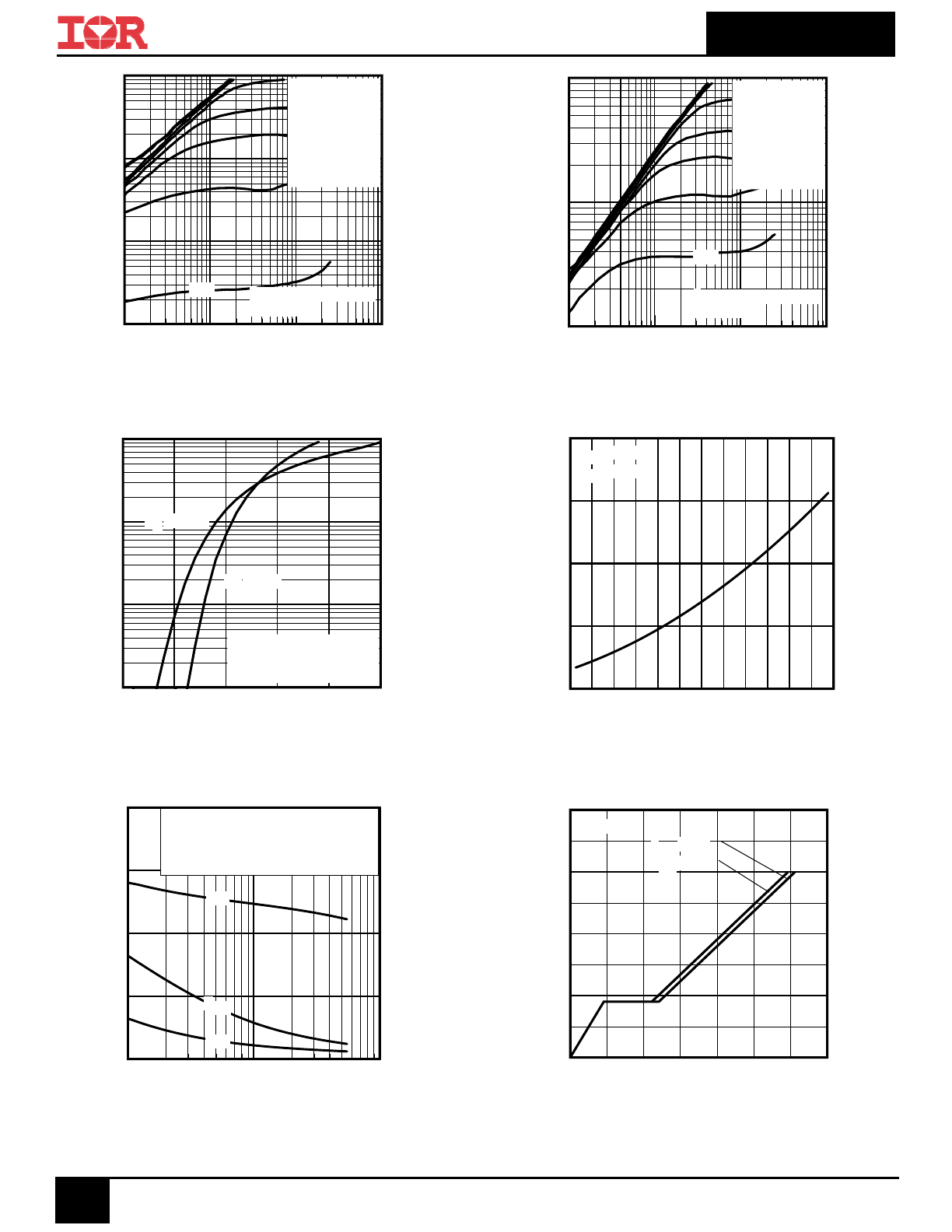
IRFP3006PbF
3
www.irf.com
© 2013 International Rectifier
September 06, 2013
Fig 2.
Typical Output Characteristics
Fig 3.
Typical Transfer Characteristics
Fig 1.
Typical Output Characteristics
Fig 6.
Typical Gate Charge vs. Gate-to-Source Voltage
Fig 5.
Typical Capacitance vs. Drain-to-Source Voltage
-60 -40 -20 0
20 40 60 80 100 120 140 160 180
TJ , Junction Temperature (°C)
0.5
1.0
1.5
2.0
2.5
R
D
S
(o
n)
,
D
ra
in
-t
o-
S
ou
rc
e
O
n
R
es
is
ta
nc
e
(
N
or
m
al
iz
ed
)
ID = 170A
VGS = 10V
Fig 4.
Normalized On-Resistance vs. Temperature
0.1
1
10
100
VDS, Drain-to-Source Voltage (V)
1
10
100
1000
I D
, D
ra
in
-t
o-
S
ou
rc
e
C
ur
re
nt
(
A
)
60µs PULSE WIDTH
Tj = 25°C
3.5V
VGS
TOP 15V
10V
8.0V
6.0V
5.0V
4.5V
4.0V
BOTTOM
3.5V
0.1
1
10
100
VDS, Drain-to-Source Voltage (V)
10
100
1000
I D
, D
ra
in
-t
o-
S
ou
rc
e
C
ur
re
nt
(
A
)
60µs PULSE WIDTH
Tj = 175°C
3.5V
VGS
TOP 15V
10V
8.0V
6.0V
5.0V
4.5V
4.0V
BOTTOM
3.5V
2.0
3.0
4.0
5.0
6.0
7.0
VGS, Gate-to-Source Voltage (V)
1
10
100
1000
I D
, D
ra
in
-t
o-
S
ou
rc
e
C
ur
re
nt
)
VDS = 25V
60µs PULSE WIDTH
TJ = 25°C
TJ = 175°C
1
10
100
VDS, Drain-to-Source Voltage (V)
0
4000
8000
12000
16000
C
, C
ap
ac
ita
nc
e
(p
F
)
VGS = 0V, f = 1 MHZ
Ciss = Cgs + Cgd, Cds SHORTED
Crss = Cgd
Coss = Cds + Cgd
Coss
Crss
Ciss
0
40
80
120
160
200
240
280
QG Total Gate Charge (nC)
0
4
8
12
16
V
G
S
, G
at
e-
to
-S
ou
rc
e
V
ol
ta
ge
(
V
)
VDS= 48V
VDS= 30V
ID= 170A

IRFP3006PbF
4
www.irf.com
© 2013 International Rectifier
September 06, 2013
-60 -40 -20 0
20 40 60 80 100 120 140 160 180
TJ , Junction Temperature (°C)
55
60
65
70
75
80
V
(B
R
)D
S
S
,
D
ra
in
-t
o-
S
ou
rc
e
B
re
ak
do
w
n
V
ol
ta
ge
ID = 5mA
Fig 8.
Maximum Safe Operating Area
Fig 9.
Maximum Drain Current vs. Case Temperature
Fig 10.
Drain-to-Source Breakdown Voltage
Fig 12.
Maximum Avalanche Energy vs. Drain Current
Fig 11.
Typical Coss Stored Energy
25
50
75
100
125
150
175
TC , Case Temperature (°C)
0
50
100
150
200
250
300
I D
,
D
ra
in
C
ur
re
nt
(
A
)
LIMITED BY PACKAGE
0.0
0.4
0.8
1.2
1.6
2.0
VSD, Source-to-Drain Voltage (V)
0.1
1
10
100
1000
I S
D
,
R
ev
er
se
D
ra
in
C
ur
re
nt
(
A
)
TJ = 25°C
TJ = 175°C
VGS = 0V
0.1
1
10
100
VDS, Drain-toSource Voltage (V)
0.1
1
10
100
1000
10000
I D
,
D
ra
in
-t
o-
S
ou
rc
e
C
ur
re
nt
(
A
)
Tc = 25°C
Tj = 175°C
Single Pulse
1msec
10msec
OPERATION IN THIS AREA
LIMITED BY R DS(on)
100µsec
DC
LIMITED BY PACKAGE
0
10
20
30
40
50
60
VDS, Drain-to-Source Voltage (V)
0.0
0.5
1.0
1.5
2.0
E
ne
rg
y
(µ
J)
25
50
75
100
125
150
175
Starting TJ, Junction Temperature (°C)
0
200
400
600
800
1000
1200
1400
E
A
S
,
S
in
gl
e
P
ul
se
A
va
la
nc
he
E
ne
rg
y
(m
J)
ID
TOP
20A
27A
BOTTOM
170A
Fig 7.
Typical Source-to-Drain Diode
Forward Voltage
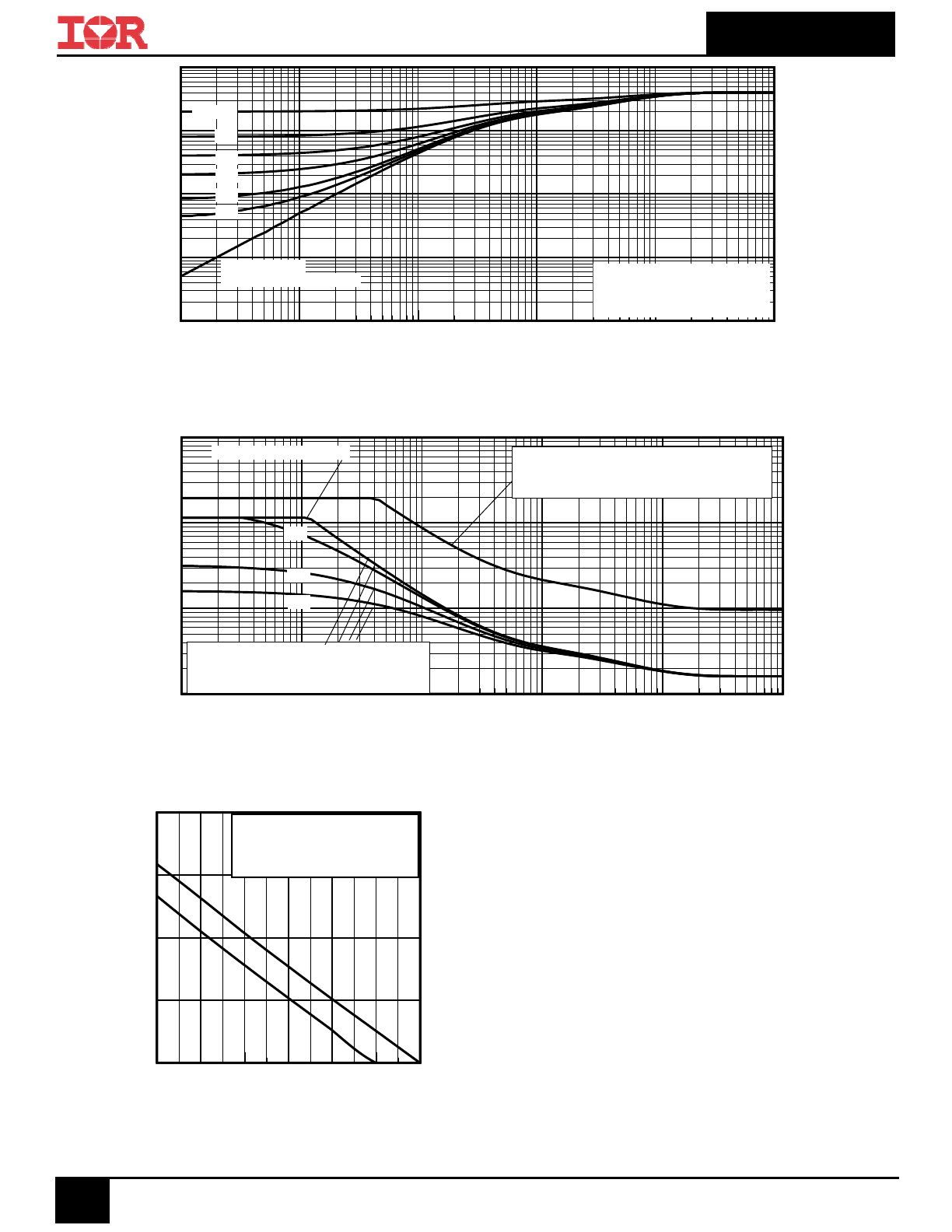
IRFP3006PbF
5
www.irf.com
© 2013 International Rectifier
September 06, 2013
Notes on Repetitive Avalanche Curves , Figures 14, 15:
(For further info, see AN-1005 at www.irf.com)
1. Avalanche failures assumption:
Purely a thermal phenomenon and failure occurs at a temperature
far in excess of Tjmax. This is validated for every part type.
2. Safe operation in Avalanche is allowed as long as Tjmax is not
exceeded.
3. Equation below based on circuit and waveforms shown in Figures
16a,
16b.
4. P
D (ave)
= Average power dissipation per single avalanche pulse.
5. BV = Rated breakdown voltage (1.3 factor accounts for voltage
increase during avalanche).
6. I
av
= Allowable avalanche current.
7.
T = Allowable rise in junction temperature, not to exceed Tjmax
(assumed as 25°C in Figure 14, 15).
t
av
= Average time in avalanche.
D = Duty cycle in avalanche = tav ·f
Z
thJC
(D, t
av
) = Transient thermal resistance, see Figures 13)
P
D (ave)
= 1/2 ( 1.3·BV·I
av
) =
T/ Z
thJC
I
av
= 2
T/ [1.3·BV·Z
th
]
E
AS (AR)
= P
D (ave)
·t
av
25
50
75
100
125
150
175
Starting TJ , Junction Temperature (°C)
0
100
200
300
400
E
A
R
,
A
va
la
nc
he
E
ne
rg
y
(m
J)
TOP Single Pulse
BOTTOM 1% Duty Cycle
ID = 170A
Fig 15.
Maximum Avalanche Energy vs. Temperature
Fig 14.
Typical Avalanche Current vs. Pulsewidth
1E-006
1E-005
0.0001
0.001
0.01
0.1
t1 , Rectangular Pulse Duration (sec)
0.0001
0.001
0.01
0.1
1
T
he
rm
al
R
es
po
ns
e
(
Z
th
JC
)
0.20
0.10
D = 0.50
0.02
0.01
0.05
SINGLE PULSE
( THERMAL RESPONSE )
Notes:
1. Duty Factor D = t1/t2
2. Peak Tj = P dm x Zthjc + Tc
1.0E-06
1.0E-05
1.0E-04
1.0E-03
1.0E-02
1.0E-01
tav (sec)
1
10
100
1000
A
va
la
nc
he
C
ur
re
nt
(
A
)
0.05
Duty Cycle = Single Pulse
0.10
Allowed avalanche Current vs avalanche
pulsewidth, tav, assuming
j = 25°C and
Tstart = 150°C.
0.01
Allowed avalanche Current vs avalanche
pulsewidth, tav, assuming
Tj = 150°C and
Tstart =25°C (Single Pulse)
Fig 13.
Maximum Effective Transient Thermal Impedance, Junction-to-Case

IRFP3006PbF
6
www.irf.com
© 2013 International Rectifier
September 06, 2013
Fig. 17
Typical Recovery Current vs. di
f
/dt
Fig 18.
Typical Recovery Current vs. di
f
/dt
Fig 19.
Typical Stored Charge vs. di
f
/dt
Fig. 16
Threshold Voltage vs. Temperature
Fig 20.
Typical Stored Charge vs. di
f
/dt
-75 -50 -25
0
25
50
75 100 125 150 175
TJ , Temperature ( °C )
1.0
1.5
2.0
2.5
3.0
3.5
4.0
V
G
S
(t
h)
G
at
e
th
re
sh
ol
d
V
ol
ta
ge
(
V
)
ID = 1.0A
ID = 1.0mA
ID = 250µA
100
200
300
400
500
600
700
800
dif / dt - (A / µs)
0
4
8
12
16
20
I R
R
M
-
(
A
)
IF = 112A
VR = 51V
TJ = 125°C
TJ = 25°C
100
200
300
400
500
600
700
800
dif / dt - (A / µs)
0
4
8
12
16
20
I R
R
M
-
(
A
)
IF = 170A
VR = 51V
TJ = 125°C
TJ = 25°C
100
200
300
400
500
600
700
800
dif / dt - (A / µs)
0
100
200
300
400
500
600
700
Q
R
R
-
(
nC
)
IF = 112A
VR = 51V
TJ = 125°C
TJ = 25°C
100
200
300
400
500
600
700
800
dif / dt - (A / µs)
0
100
200
300
400
500
600
700
Q
R
R
-
(
nC
)
IF = 170A
VR = 51V
TJ = 125°C
TJ = 25°C
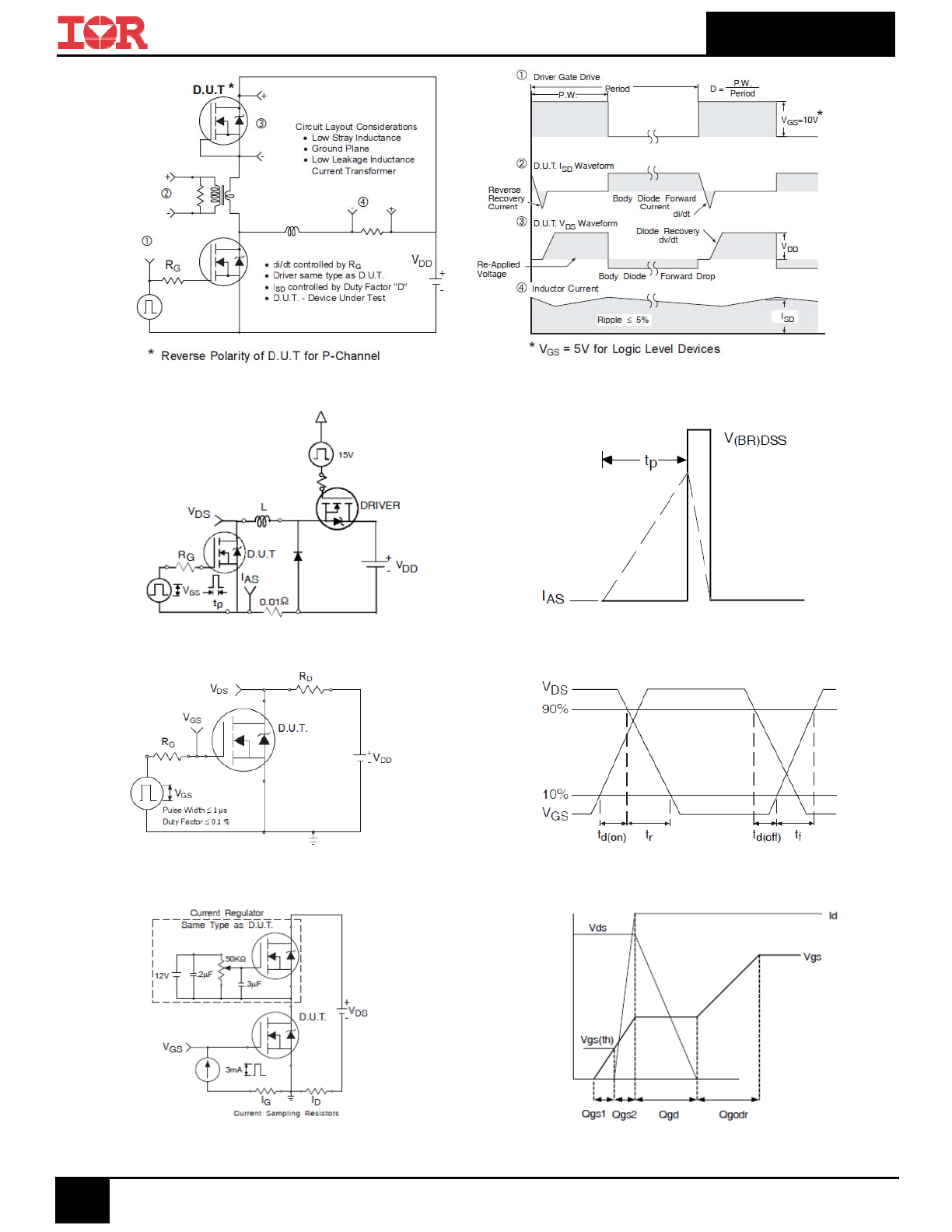
IRFP3006PbF
7
www.irf.com
© 2013 International Rectifier
September 06, 2013
Fig 21.
Peak Diode Recovery dv/dt Test Circuit for N-Channel HEXFET® Power MOSFETs
Fig 22b.
Unclamped Inductive Waveforms
Fig 22a.
Unclamped Inductive Test Circuit
Fig 23a.
Switching Time Test Circuit
Fig 23b.
Switching Time Waveforms
Fig 24a.
Gate Charge Test Circuit
Fig 24b.
Gate Charge Waveform

IRFP3006PbF
8
www.irf.com
© 2013 International Rectifier
September 06, 2013
Note: For the most current drawing please refer to IR website at
http://www.irf.com/package/
TO-247AC package is not recommended for Surface Mount Application.
TO-247AC Part Marking Information
TO-247AC Package Outline
(Dimensions are shown in millimeters (inches))

IRFP3006PbF
9
www.irf.com
© 2013 International Rectifier
September 06, 2013
IR WORLD HEADQUARTERS:
101N Sepulveda Blvd, El Segundo, California 90245, USA
To contact Interna onal Rec fier, please visit
h p://www.irf.com/whoto‐call/
Qualification information
†
Qualification level
Industrial
(per JEDEC JESD47F
)
††
Moisture Sensitivity Level
TO-247AC
N/A
RoHS compliant
Yes
†
Qualification standards can be found at International Rectifier’s web site
http://www.irf.com/product-info/reliability
††
Applicable version of JEDEC standard at the time of product release.
